
Eaton 9E-IN User Manual
Tower 6-10K

Service and support:
Call your local service representative
SAFETY INSTRUCTIONS
SAVE THESE INSTRUCTIONS. This manual contains important instructions that
should be followed during installation and maintenance of the UPS and
batteries.
The UPS models that are covered in this manual are intended for installation in
an environment within 0 to 50°C, free of conductive contaminant.
Certification standards
•
Safety: EN 62040-1
•
EMC: IEC/EN 62040-2
•
IEC 61000-4-2 (ESD): level 3.
•
IEC 61000-4-3 (Radiated field): level 3.
•
IEC 61000-4-4 (EFT): level 4.
•
IEC 61000-4-5 (Fast transients): level 4.
•
IEC 61000-4-6 (Electromagnetic field): level 3.
•
IEC 61000-4-8 (Conducted magnetic field): level 4.
•
Performance: IEC/EN 62040-3
Special symbols
The following are examples of symbols used on the UPS or accessories to alert you
to important information:
RISK OF ELECTRIC SHOCK - Observe the warning associated with the risk of electric
shock symbol.
Important instructions that must always be followed.
Do not discard the UPS or the UPS batteries in the trash.
This product contains sealed lead acid batteries and must be disposed as it's explain
in this manual. For more information, contact your local recycling/reuse or
hazardous waste center.
This symbol indicates that you should not discard waste electrical or electronic
equipment (WEEE) in the trash. For proper disposal, contact your local
recycling/reuse or hazardous waste center.
Information, advice, help.

Refer to the user manual.
Safety of persons
RISK OF VOLTAGE BACKFEED. The system has its own power source (the
battery). Isolate the UPS and check for hazardous voltage upstream and
downstream during lockout-tagout operation. Terminal blocks may be
energized even if the system is disconnected from the AC power source.
Dangerous voltage levels are present within the system. It should be opened
exclusively by qualified service personnel.
The system must be properly grounded.
The battery supplied with the system contains small amounts of toxic
materials. To avoid accidents, the directives listed below must be observed:
- Servicing of batteries should be performed or supervised by personnel
knowledgeable about batteries and the required precautions.
- When replacing batteries, replace with the same type and number of
batteries or battery packs.
- Do not dispose of batteries in a fire. The batteries may explode.
- Batteries constitute a danger (electrical shock, burns). The short-circuit
current may be very high.
Precautions must be taken for all handling:
- Wear rubber gloves and boots.
- Do not lay tools or metal parts on top of batteries.
- Disconnect charging source prior to connecting or disconnecting battery
terminals.
- Determine if battery is inadvertently grounded. If inadvertently grounded,
remove source from ground. Contact with any part of a grounded battery
can result in electrical shock. The likelihood of such shock can be reduced if
such grounds are removed during installation and maintenance (applicable
to equipment and remote battery supplies not having a grounded supply
circuit).
Product safety
The UPS connection instructions and operation described in the manual must
be followed in the indicated order.
CAUTION - To reduce the risk of fire, the unit connects only to a circuit
provided with branch circuit overcurrent protection for :
63A rating, for 6kVA models,
100A rating, for 10kVA models
The upstream circuit breaker for Normal AC/Bypass AC must be easily

accessible. The unit can be disconnected from AC power source by opening this
circuit breaker.
An additional AC contactor is used for backfeed protection and must comply
with IEC/EN 62040-1 (the creep age and clearance distances shall meet the
basic insulation requirements for pollution degree 2).
Disconnection and overcurrent protection devices shall be provided by others
for permanently connected AC input (Normal AC/Bypass AC) and AC output
circuits.
Check that the indications on the rating plate correspond to your AC powered
system and to the actual electrical consumption of all the equipment to be
connected to the system.
For PLUGGABLE EQUIPMENT, the socket-outlet shall be installed near the
equipment and shall be easily accessible
Never install the system near liquids or in an excessively damp environment.
Never let a foreign body penetrate inside the system.
Never block the ventilation grates of the system.
Never expose the system to direct sunlight or source of heat.
If the system must be stored prior to installation, storage must be in a dry
place.
The admissible storage temperature range is -25°C to +60°C with battery(-15°C
to +40°C without battery).
Special precautions
The unit is heavy: wear safety shoes and use vacuum lifter preferentially for
handling operations.
All handling operations will require at least two people (unpacking, lifting,
installation in rack system).
Straps are provided only for unpacking manually the unit from the carton;
don’t use the straps to carry the unit around. The unit can slip from the straps
during handling (risk of injury and product damage):
- keep 12in / 30cm minimum distance between the straps
- lift the unit carefully and keep it at low height
- keep the unit horizontal during unpacking.
Before and after the installation, if the UPS remains de-energized for a long
period, the UPS must be energized for a period of 24 hours, at least once every
6 months (for a normal storage temperature less than 25°C). This charges the
battery, thus avoiding possible irreversible damage.
During the replacement of the Battery Module, it is imperative to use the same
type and number of element as the original Battery Module provided with the
UPS to maintain an identical level of performance and safety.

Contents
1. INTRODUCTION ............................................................................................ 1
1.1 ENVIRONMENTAL PROTECTION ............................................................................... 1
2. PRESENTATION ............................................................................................. 3
2.1 FRONT PANEL ...................................................................................................... 3
2.2 REAR PANELS ...................................................................................................... 4
2.3 CIRCUIT DIAGRAM ............................................................................................... 5
3. INSTALLATION ............................................................................................... 6
3.1 INSPECTING THE EQUIPMENT ................................................................................. 6
3.2 UNPACKING THE UNIT .......................................................................................... 6
3.3 CHECKING THE ACCESSORY KIT ................................................................................ 8
3.4 INSTALL THE UNIT ................................................................................................ 8
4. POWER CABLES CONNECTION .................................................................... 10
4.1 ACCESS TO TERMINAL BLOCKS (AC SOURCE TO UPS) ................................................ 11
4.3 PARALLEL INSTALLATION AND OPERATION (OPTIONAL) .............................................. 12
5. OPERATION ................................................................................................ 16
5.1 CONTROL PANEL ................................................................................................ 16
5.2 LCD DESCRIPTION.............................................................................................. 18
5.3 DISPLAY FUNCTIONS ........................................................................................... 21
5.4 USER SETTINGS ................................................................................................. 21
5.5 UPS STARTUP AND SHUTDOWN ............................................................................ 22
5.6 LCD OPERATION ................................................................................................ 24
6. COMMUNICATION ...................................................................................... 32
6.1 COMMUNICATION PORTS .................................................................................... 32
6.2 INTELLIGENT CARD (OPTIONAL)............................................................................ 33
6.3 UPS MANAGEMENT SOFTWARE ........................................................................... 33
7. UPS MAINTENANCE .................................................................................... 34

7.1 EQUIPMENT CARE .............................................................................................. 34
7.2 TRANSPORTING THE UPS .................................................................................... 34
7.3 STORING THE EQUIPMENT ................................................................................... 34
7.4 REPLACING BATTERIES ........................................................................................ 35
7.5RECYCLING THE USED EQUIPMENT.......................................................................... 36
8. TROUBLESHOOTING ................................................................................... 37
8.1 TYPICAL ALARMS AND FAULTS ............................................................................... 37
8.2 SILENCING THE ALARM ........................................................................................ 41
9. SPECIFICATIONS .......................................................................................... 42
9.1 MODEL SPECIFICATIONS ...................................................................................... 42
10 GLOSSARY .................................................................................................. 47

1
1. Introduction
Thank you for selecting UPS to protect your electrical equipment. The UPS has
been designed with the utmost care.
We recommend that you take the time to read this manual to take full
advantage of the many features of your UPS (Uninterruptible Power System).
Before installing your UPS, please read the booklet presenting the safety
instructions. Then follow the indications in this manual.
1.1 Environmental protection
Products are developed according to an eco-design approach.
Substances
This product does not contain CFCs, HCFCs or asbestos.
Packing
To improve waste treatment and facilitate recycling, separate the various
packing components.
•
The cardboard we use comprises over 50% of recycled cardboard.
•
Sacks and bags are made of polyethylene.
•
Packing materials are recyclable and bear the appropriate identification
symbol
Materials
Abbreviations
Number in
the symbols
Polyethylene terephthalat
PET
01
High-density polyethylene
HDPE 02
Polyvinyl chloride
PVC 03
Low-density polyethylene
LDPE 04
Polypropylene
PP 05
Polystyrene
PS 06
Follow all local regulations for the disposal of packing materials.

2
Product
The product is made up of recyclable materials.
Dismantling and destruction must take place in compliance with all local
regulations concerning waste. At the end of its service life, the product must be
transported to a processing center for electrical and electronic waste.
Battery
The product contains lead-acid batteries that must be processed according to
applicable local regulations concerning batteries.
The battery may be removed to comply with regulations and in view of correct
disposal.
1.2 Electronic equipment protection
The uninterruptible power system (UPS) protects your sensitive electronic
equipment from the most common power problems, including power failures,
power sags, power surges, brownouts, line noise, high voltage spikes,
frequency variations, switching transients, and harmonic distortion.
Power outages may occur unexpected, and the power quality will be erratic.
These power problems have the potential to corrupt critical data, destroy
unsaved work sessions, and damage hardware - causing hours of lost
productivity and expensive repairs.
With the UPS, you can safely eliminate the effects of power disturbances and
guard the integrity of your equipment. Providing outstanding performance and
reliability, UPS’s unique benefits include:
True online double-conversion technology with high power density, utility
frequency independence, and generator compatibility.
Selectable High Efficiency mode of operation.
Standard communication options: one RS232 communication port, one
USB communication port, one dry in port and dry out port.
Optional connectivity cards with enhanced communication capabilities.
Firmware that is easily upgradable without a service call.

3
2. Presentation
2.1 Front panel
Tower model:
Tower UPS 6KS/10KS Tower UPS 6K/10K Tower EBM

4
2.2 Rear panels
Tower model:
Tower UPS 6KS Tower UPS 10KS
Tower UPS 6K Tower UPS 10K Tower EBM
1. Intelligent slot
2. USB
3. RS232
4. RJ11 (only for RT model)
5. EPO
6. Parallel card (optional)
7. Dry IN/OUT
8. Input /Output terminal
(Standard model 5pole, IPL, IPN, PE,
OPL, OPN; long backup model has 2
version, one is 5 Pole. Another is 7pole.
7pole add bat+, bat-, and no external
battery connector #10.)
9. Input switch
10. External battery connector
11. Maintenance bypass switch (optional)
12. EBM connector
13. EBM connector
14. Fuse board cover (replace EBM fuse)

5
2.3 Circuit diagram

6
3. Installation
It is recommended to move the equipment to the installation site by using a
pallet jack or a truck before unpacking.
The system may be installed only by qualified electricians in accordance with
applicable safety regulations.
The cabinet is heavy, please install it with at least two peoples.
3.1 Inspecting the equipment
If any equipment has been damaged during shipment, keep the shipping
cartons and packing materials for the carrier or place of purchase and file a
claim for shipping damage. If you discover damage after acceptance, file a claim
for concealed damage.
3.2 Unpacking the Unit
Unpacking the unit in a low-temperature environment may cause
condensation occurred in and on the cabinet. Do not install the unit until
the inside and outside of the unit are absolutely dry (hazard of electric
shock).
Remove the packing materials and lift the unit out with two people at least.
Tower 6KS/10KS
Tower 6K/10K
Tower EBM

7
Note:
The cabinet is heavy, please see spec weight provided on the carton/label.
Do not lift the unit’s front panel and rear panel.
Discard or recycle the packaging in a responsible manner, or store it for future
use.
Packing materials must be disposed in compliance with all local regulations
concerning waste. Recycling symbols are printed on the packing materials to
facilitate sorting.

8
3.3 Checking the accessory kit
Verify that the following additional items are included with the unit:
Tower
UPS
6K/10K
Tower
UPS
6KS/10KS
Tower
EBM
Battery power
cable
V V
USB cable
V V
RS232 cable
O O
Parallel cable
O O
Dry contractor
V V
EPO contractor
* *
Stabilizer
bracket
V
V
Extension plate
of Stabilizer
bracket
Ear bracket
Rail kit
User manual
V V V
V: standard configuration
*: assembled to unit
O: optional configuration
If you ordered other accessories, please contact with local sale center.
3.4 Install the unit
3.4.1 Tower model
UPS model
To keep air-flowing freely, it is recommended to keep a clearance with 500mm
space both for front and rear side.
1. Place the unit on a flat, stable surface in its final location,
2. Install ‘Stabilizer bracket’ (optional): remove side’s screw from the unit, then

9
install ‘Stabilizer bracket’ to the unit.
3. Install the unit to a surface (optional): place 4pcs bolts (M8 is recommended)
to the final location previously, bolt’s position please refer to below, then fix
the unit to the bolts.
EBM model
1. Install the EBM model----Refer to UPS model installation as above.
2. Connect EBM to UPS with ‘Battery power cable’.
Note:
This ‘Battery power cable’ may have different plug according to the number of
battery inside of this unit, please check the ‘Voltage ’ parameter on rear-panel if it
matches the UPS before connection.
The battery number can be adjusted from ‘16pcs*2 strings’ to ‘20pcs*2 strings’ for
this unit, if you ordered other type EBM, please contact with local sale center.
If installing additional unit, place it next to the previous unit in their final location.

10
4. Power cables connection
Recommended protective devices and cable cross-sections
Recommended upstream protection
UPS power rating Upstream circuit breaker
6
000VA
D curve
–
63
A
1
0
000VA
D curve
–
100
A
G N(L2) L1
Read the Safety instructions page 3 regarding backfeed protection requirements.
Recommended cable cross-sections
Model 6K 10K
Protective earthing conductor
Min cross section
6mm^2 (8AWG) 10mm^2 (6AWG)
Input L, N, G
Min conductor cross section
6mm^2 (8AWG) 10mm^2(6AWG)
Input fuse 80A 100A
Output L,N,
Min conductor cross section
6mm^2 (8AWG) 10mm^2(6AWG)
Battery cable* 6mm^2 (8AWG) 10mm^2 (6AWG)
Note *: It suggests to use standard battery cable in package when connects battery pack with
UPS. If additional battery cable needed for installation, it must follow cable specification and
the maximum length of battery cable 10 meters for application.
If a length of battery cable over 10 meters requests, please contact distributors/agents for
details.
It is recommended that an external isolating device should be installed between
the mains input and UPS as shown in Figure
N(L2)
to UPS Normal AC / Bypass AC source

11
4.1 Access to terminal blocks (AC source to UPS)
High leakage current:
Earth connection essential before connecting supply.
Common input/output sources connection
This type of connection must be carried out by qualified electrical personnel
Before carrying out any connection, check that the upstream protection devices
(Normal AC source and Bypass AC source) are open "O" (Off).
Always connect the ground wire first
1. Remove the cover of terminal block.
2. Connect the AC cable to terminal blocks refer to the indication on rear panel
Tower model:
3. Tie up the AC cable to the rear panel.
4. Install back the cover of terminal block.

12
4.3 Parallel Installation and Operation (Optional)
As long as the UPS is equipped with parallel board and parallel cables, up to 3
UPSs can be connected in parallel to configure a sharing and redundant output
power.
How to install a new parallel UPS system:
1) Before installing a new parallel UPS system, please prepare the input
/output wires, breakers, and a main maintenance mechanical switch or
static switch.
2) Independent battery packs for each UPS.
3) Remove the cover plate of parallel port on the UPS, connect each UPS one
by one with parallel cable, and make sure the cable is screwed tightly.

13
4) Install ‘cable locker’ to protect the ‘parallel cable’ for each UPS.
5) Connect the input and output wires and make sure all the breakers are
turned off.
Tower model:

14
6) Turn on the input breakers for the parallel UPS.
7) Pressing button continuously for more than 1 second for one UPS of
the system, then the system will turn to line mode.
8) Regulate the output voltage of the each UPS separately, and check if the
difference of output voltage is less than 0.5V among the parallel system. If
the difference is more than 0.5V, the UPS need to be regulated.
9) If the difference output voltage is less than 0.5V, turn off the input breakers
to let UPS shut down. And then switch on the output breakers for all the
UPS.
10) Switch on the input breakers for the parallel UPS. Pressing button
continuously more than 1 second for one UPS of the system, then the
system will turn to line mode, after these operations, the system will work
normally in parallel mode.
Note: The output wiring requirement as below:
1) If the distance between the UPS and breaker panel is less than 20 meters in
parallel system, the length difference between input and output cable of
the UPSs is required to be less than 20%.
2) If the distance between the UPS and breaker panel is more than 20 meters
in parallel system, the length difference between input and output cable of
the UPSs is required to be less than 5%.
2. How to join a new UPS to parallel system:
1) Firstly, a main maintenance mechanical switch or static switch should be
installed for the parallel system.
2) Regulate the output voltage of the new UPS: check if the output voltage
difference between the new UPS and the parallel system is less than 0.5V.
3) Ensure the bypass of the parallel system is normal and the auto bypass
setting is “enable”, then press the button to turn off the UPS, the UPS
will turn to bypass mode.
4) Set the main maintenance switch or static switch from “UPS” to “BPS”, then
switch off the main output breaker, input breaker and mains breaker, then
the UPS will shut down.
5) Connect the cable and wire for the new ups.
6) Switch on the input breakers and mains breaker, and make sure that every
UPS work in bypass mode.
7) Switch on the O/P breakers and main O/P breaker,transfer the main
maintenance switch or static switch from “BPS” to “UPS”.
Page is loading ...
Page is loading ...
Page is loading ...
Page is loading ...
Page is loading ...
Page is loading ...
Page is loading ...
Page is loading ...
Page is loading ...
Page is loading ...
Page is loading ...
Page is loading ...
Page is loading ...
Page is loading ...
Page is loading ...
Page is loading ...
Page is loading ...
Page is loading ...
Page is loading ...
Page is loading ...
Page is loading ...
Page is loading ...
Page is loading ...
Page is loading ...
Page is loading ...
Page is loading ...
Page is loading ...
Page is loading ...
Page is loading ...
Page is loading ...
Page is loading ...
Page is loading ...
Page is loading ...
-
 1
1
-
 2
2
-
 3
3
-
 4
4
-
 5
5
-
 6
6
-
 7
7
-
 8
8
-
 9
9
-
 10
10
-
 11
11
-
 12
12
-
 13
13
-
 14
14
-
 15
15
-
 16
16
-
 17
17
-
 18
18
-
 19
19
-
 20
20
-
 21
21
-
 22
22
-
 23
23
-
 24
24
-
 25
25
-
 26
26
-
 27
27
-
 28
28
-
 29
29
-
 30
30
-
 31
31
-
 32
32
-
 33
33
-
 34
34
-
 35
35
-
 36
36
-
 37
37
-
 38
38
-
 39
39
-
 40
40
-
 41
41
-
 42
42
-
 43
43
-
 44
44
-
 45
45
-
 46
46
-
 47
47
-
 48
48
-
 49
49
-
 50
50
-
 51
51
-
 52
52
-
 53
53
Eaton Tower 10KS User manual
- Type
- User manual
Ask a question and I''ll find the answer in the document
Finding information in a document is now easier with AI
Related papers
-
Eaton DX RT 6K UPS User manual
-
Eaton 1000H(XL) User manual
-
Eaton 9E-IN 1K XL User manual
-
Eaton 9PX EBM 48V RT Installation and User Manual
-
Eaton 9SXEBM36R Installation and User Manual
-
Eaton 5000 VA User manual
-
Eaton 9SX 15KPMAU Series User manual
-
Eaton 5PX 2200i RT2U User manual
-
Eaton Powerware 9135 User manual
-
Eaton Powerware 9130 User manual
Other documents
-
PowerWalker VFI 10000 TGS PF1 Owner's manual
-
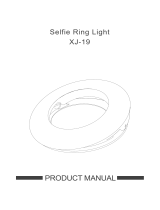 Cliusnra Cliusnra Led Selfie Ring Light: Camera Mini Portable Beauty Lamp Phone Photo Video Holder Attachment Adjustable Round Circle Rechargeable Night Makeup Enhancer Clipon Computer On-Camera Accessories User manual
Cliusnra Cliusnra Led Selfie Ring Light: Camera Mini Portable Beauty Lamp Phone Photo Video Holder Attachment Adjustable Round Circle Rechargeable Night Makeup Enhancer Clipon Computer On-Camera Accessories User manual
-
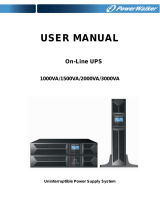 BlueWalker 1000VA User manual
BlueWalker 1000VA User manual
-
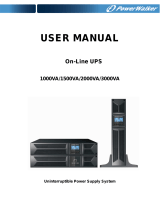 Power Walker 1000VA User manual
Power Walker 1000VA User manual
-
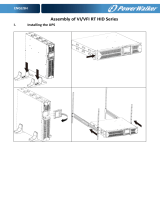 PowerWalker VFI 1500 RT HID Owner's manual
PowerWalker VFI 1500 RT HID Owner's manual
-
BlueWalker PowerWalker VI 2000RT LCD User manual
-
PowerWalker VFI 10000 CPR 3/1 BX Owner's manual
-
EMC UPS 10000VA User manual
-
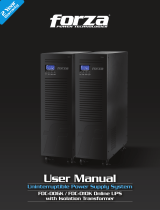 Forza Power Technologies FDC-006K Troubleshooting guide
Forza Power Technologies FDC-006K Troubleshooting guide
-
Repotec RP-UPH104T Owner's manual

























































